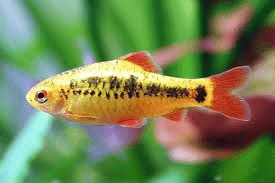
Common name: Gold Barb, China Barb, Half Banded Barb, Shubert’s Barb, Six-banded Barb
Scientific name: Puntius Semifasciolatus
Average Adult Fish Size: 2.8 inches / 7 cm
Place of Origin: Southeast Asia
Typical Tank setup: A well planted aquarium with rock work and driftwood / bogwood. Plants will give the weaker individuals a place to hide, until the pecking order of the school is established.
Recommended Minimum Aquarium Capacity: 30 gallon / 120 litre
Compatibility: The Gold Barb needs to be kept in schools. The larger the school the better with 9 fish a good minimum amount. If kept in smaller schools the weaker individuals will be harassed continuously by the more aggressive individuals until they die. Gold Barbs have a tendency to nip the fins of slow fish and ones that have long flowing fins. The way to combat this is to keep them in a large enough school. If this is done, they will generally keep themselves busy within the school and usually not bother their tankmates too much. If kept with smaller fish, they too should be kept in a school.
Temperature: 64 – 75 Deg F / 18 – 24 Deg C
Water chemistry: pH 6.0 – 7.5
Feeding: In their natural habitat, Gold Barbs consume both vegetable and meaty foods ranging from plant matter to insects and small worms. Omnivores like the Gold Barb should be fed a varied diet containing both plant and meaty foods in order to provide them all the nutrients that they need to support a healthy immune system and slime coat. Hobbyists should feed the Gold Barb a quality flake food designed for tropical omnivores mixed with algae or plant based flaked foods. In addition to quality flaked foods, Gold Barbs should be offered quality frozen foods, blood worms, tubifex worms, brine shrimp and similar fair to mix up their diet and provide them a wide range of nutritional foodstuffs.
Sexing: Females are much duller overall in colouration, and are rounder in the belly. They are often slightly larger overall than the male. The belly of mature males who are ready to spawn will turn red to red-orange in colour.
Breeding: Gold barbs are prolific in the wild and have a minimum population doubling lower than 15 months. They can spawn several times a year. The Gold barb is an egg-scattering species and roughly one hundred eggs are released during each spawning. The eggs will be released when the fish notice the first signs of sun beams in the early morning.
If you want to breed Gold barbs, it can be a good idea to set up a special breeding aquarium. Since Gold barbs are egg-scatterers that do not engage in parental care, they may very well eat their own eggs and fry. Sexing gold barbs are not hard, since the female will have a bulkier body than the male and display a duller body colouration. During the breeding period, the male Gold barb will display an orange-red belly.
A breeding aquarium should be at least 60 centimetres (24 inches) long, since the male will court the female quite violently during the breeding period. He will swim around her in circles and push her around with his mouth open. He will also strike her with his tail and try to force her to swim to a planted part of the aquarium where the eggs can be released. Just as in the wild, the eggs will be released when the water becomes light after the night.
When the eggs have been released and fertilized, you should remove the parents from the breeding aquarium to ensure high fry survival. The eggs are of a yellowish shade and will hatch within 1 or 2 days. After a few more days, the fry will be free swimming and can be fed rotifers and newly hatched nauplii.
If you do not want to set up a separate breeding aquarium, you can instead keep the ordinary aquarium densely planted and include a lot of bushy plant species that will provide good hiding spots for fry. A lot of eggs and fry will still be eaten, but just like in the wild a few will survive by staying hidden among the plants.
Additional Information: The naturally occurring colour of this Barb is green, but that colour is rarely seen in the aquarium trade due to the popularity of the gold form. Virtually all specimens currently sold are captive bred, and a few other colour variations have subsequently arisen, including an albino variant as well as a tricolor variation.


Related Posts
Croaking Gourami – Trichopsis vittatus
Benthochromis Tricoti
Large-eyed Mouthbrooder – Callochromis Macrops